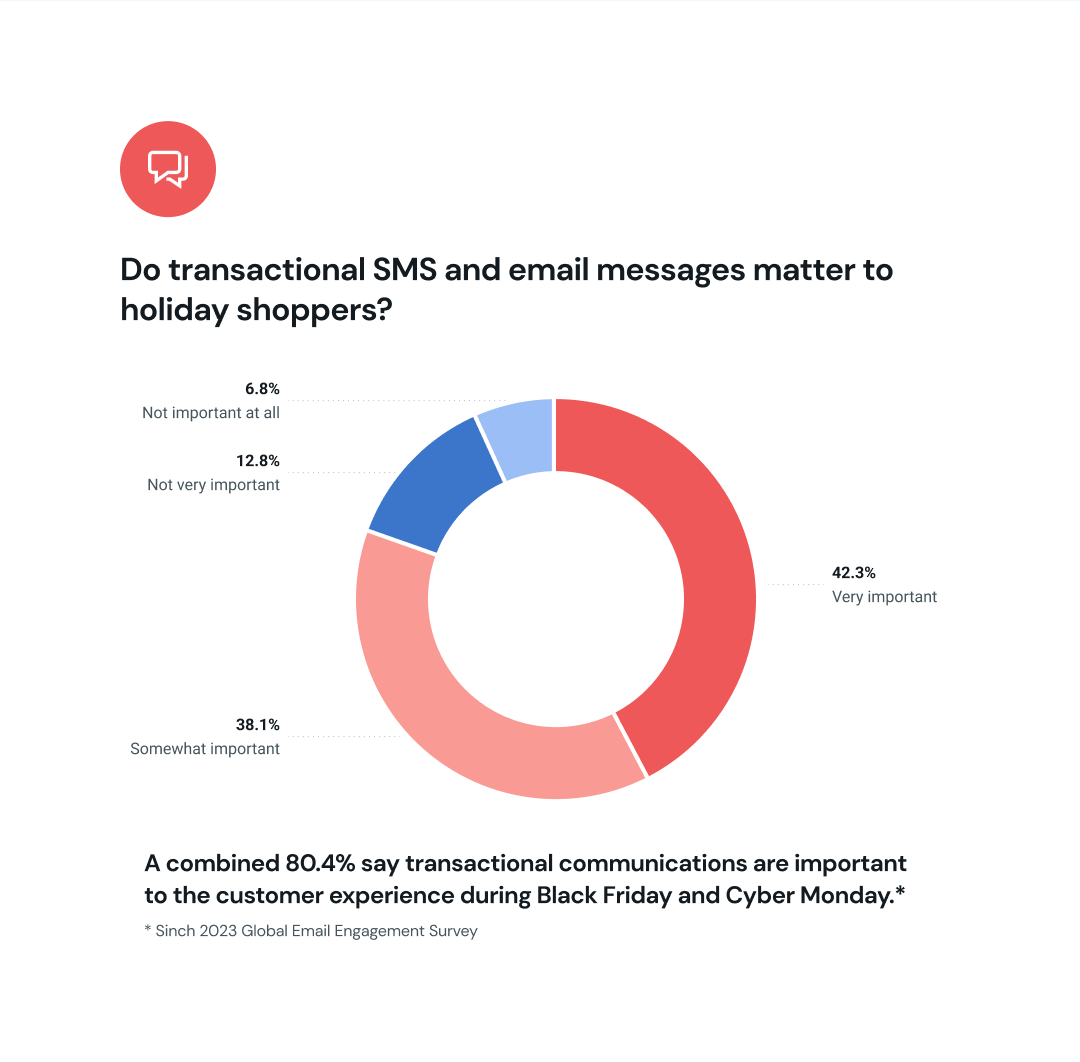Deliverability
What’s coming for email in 2024
2024 is kicking off with some major changes, starting with Gmail and Yahoo transforming how many senders monitor and manage their email programs. Even though this is big news, it’s not all that’s in store for 2024. We’ve consulted Kate Nowrouzi, VP of Deliverability at Sinch (our version of a crystal ball) and the predictions are in.
PUBLISHED ON
If you’re a frequent Mailgun reader, you’ll know we always try to help our customers with some email predictions for the year ahead. And, let’s be honest, some years are harder than others when it comes to predicting where email will go. The good news? 2024 is not one of those years.
Luckily, we don’t need to wait for a groundhog to see its shadow when the year kicks off strong with planned inbox updates from two of the largest providers – Gmail and Yahoo. Throw in generative AI tools and a sea of metrics, and email is in for quite a ride.
In this post we’re covering the five predictions that pack the biggest punch. Let’s dive in.
Table of contents
Stricter protections for senders and the inbox
Gmail and Yahoo have announced major changes impacting the inbox effective early 2024 and that will significantly impact the way bulk senders think about email.
Changes will hold senders below a designated spam complaint rate, require that a single-click unsubscribe process be implemented for promotional emails, and – most significantly – enforce a minimum DMARC authentication policy.
Why is this happening? Well, the short version is that mailbox providers are motivated to create a better, safer inbox experience for users, and that means protecting them from spammers and unwanted messages.
The best way to do this is by making authentications like DMARC mandatory. DMARC is an authentication that checks for alignment between both SPF and DKIM authentications and uses a policy set by the sender to inform the receiving server how authentication failures should be handled, whether they be rejected or quarantined. DMARC can also be configured with a “none” policy. This puts the message filtering decision in the hands of the receiving server.
DMARC policy options:
Reject: Messages that fail authentication should not be delivered (
p=reject).Quarantine: Messages that fail authentication should be filtered into the spam folder (
p=quarantine).None: Provides no guidance. Mailbox providers must decide how to filter authentication failures (
p=none).
Currently, p=none is the minimum policy required by the new standards, but this is likely a way to ensure that all senders adopt DMARC in general. By the end of 2024, it’s possible (and we think likely) that both Gmail and Yahoo will be requiring stricter policies of p=reject which will put the responsibility on senders to instruct receiving mail servers to reject messages that fail authentication.
Learn more: Have questions about DMARC? We'll walk you through it all in our post "How to implement DMARC.”
Customer-centric sending across multiple channels
Email may still be the primary channel for many enterprises, but different channels have different strengths and in 2024 companies will have to adopt omnichannel sending to meet customers where they are.
Some customers may appreciate email more for notifications on promotions and SMS for more urgent updates. In our recent 2023 Global Engagement Survey, A combined 80.4% of respondents said that receiving transactional messaging (both via email and SMS) was important to the customer experience throughout peak sending days like Black Friday and Cyber Monday. 35.6% of consumers preferred at least one mobile messaging option to receive promotional updates.
If you think about how you want to receive information, you’ll see you also have your own personal preferences. Often SMS makes more sense for urgent updates like shipping notifications, reminders, or confirmations, whereas email is a better platform for notifications like password resets, promotional updates, or newsletters.

In 2024, senders will be encouraged to implement smarter, data-driven targeting across channels rather than engaging their entire audiences or relying on a single communications pathway.
Creating an omnichannel marketing solution that works for your company is a lot like creating a strong email deliverability strategy. Brands will need to embrace data and base their decisions on user activity and intention to create personalized event triggered messaging.
Learn more: Hear about the benefits and best practices of omnichannel sending from our deliverability pros as they sit down with Chad White, Head of Research at Oracle Marketing Consulting in this episode of Email’s Not Dead.
Strategies will integrate further with generative AI
We can’t un-erupt the volcano of AI. Generative AI tools are being heavily integrated into SaaS and CPaaS platforms with the primary goal of improving product offerings to include AI features but we haven’t even scratched the surface when it comes to AI.
In 2024, we will see a much bigger focus on incorporating generative AI into workflows behind the scenes. AI will be integrated into copy creation and automation, but we will also see it have a strong impact on A/B testing for subject lines and targeted campaigns.
As we move forward into 2024 and beyond, it will be important to understand the scope, benefits, and risks of these tools. From a communications perspective, AI has many strong implications, both in terms of strengthening the efficiency of teams and by improving processes from testing to content creation.
Learn more: Generative AI first hit the scene in the form of ChatGPT by OpenAI, but Google and other competitors are developing and releasing their own solutions. Get the lay of the land in our post on using generative AI to automate your email program.
Our relationship with generative AI is still developing, so it’s hard to know where this technology is headed and how it’ll be affected by new data privacy policies. Our prediction is that in 2024 the focus for many companies will be on integrating AI tools into their workflows, rather than solely focusing on developing AI features and products as we saw in 2023.
Sustainable email practices will be prioritized
We don’t really think of email as being a major drain on environmental resources. In fact, we may already think it’s doing its part by reducing unwanted paper mail like bills. But when you think about email in terms of energy consumption, your perspective may shift.
Think about how many emails are sent. At peak sending times, like Black Friday, Sinch Email alone sent over 2 billion emails on that single day. And according to the BBC, sending just 65 emails is equivalent to driving 1km in a car in terms of CO2 emissions.
While email is a cheap and efficient way to communicate, that doesn’t mean it’s carbon neutral. The good news is the answer to making email more sustainable is also one of the key components to improving your deliverability. Keeping your email list validated and using smart segmentation practices to send the most relevant messages to your recipients. Send less, send smarter, convert more.
In 2024, we anticipate that the focus will emphasize practices such as list segmentation for targeted outreach, robust validation processes to reduce unnecessary energy consumption, and implementing easy one-click unsubscribe processes for recipients to keep lists healthy and streamlined. This shift towards sustainability not only aligns with corporate social responsibility but also ensures that email communication remains efficient and effective in terms of ROI.
Sending less paper mail reduces waste. Sending less electronic mail conserves energy.
Metrics will become more centralized
Data fatigue is a real disease when it comes to metric analysis. Centralizing these metrics into a single platform can cut down on multi-platform use, help manage access and enforce security, and gain further insights by viewing metrics from different tools or mailboxes alongside those of your general sending.
In email, the growing emphasis on monitoring metrics between platforms like Google Postmaster Tools and Microsoft SNDS, which already offer in-depth and mailbox specific metrics on their platforms and can be integrated into your ESP, will trigger a shift in how metrics are viewed and implemented.
In 2024, senders will prioritize integrated, granular dashboards over disparate accounts. These integrated dashboards will become critical in assessing performance, especially as more companies embrace omnichannel sending and as more mailbox providers develop their own standards and monitoring.
This move towards data centralization will make it easier to manage these omnichannel communications and will enable organizations to keep up with new inbox standards and evolving data policies.
Learn more: Learn how to integrate the tools you need with our guides on Google Postmaster Tools and Microsoft SNDS.
Wrapping up
Like we said, it’s going to be a big year for email.
As we move into 2024, we will see changes right away within the inbox that will have major impacts on senders throughout the year. But 2024 isn’t just about mailbox giants changing the game, it’s largely about data and how we should leverage emerging technologies to be more efficient and more conscious with our communications.
What did you think of our 2024 predictions? If you want more insights like these, be sure to subscribe to our newsletter.





